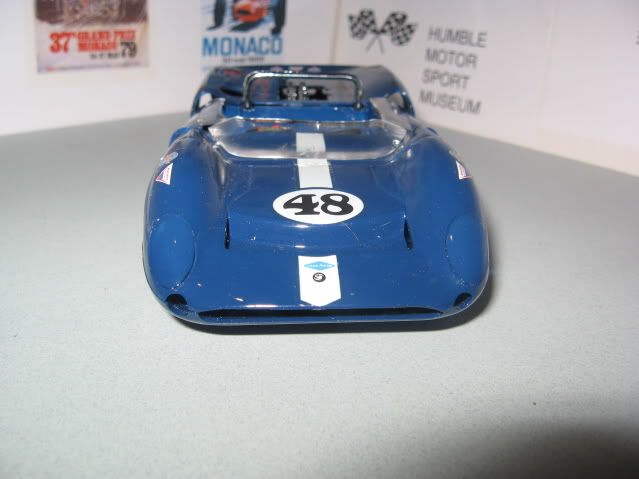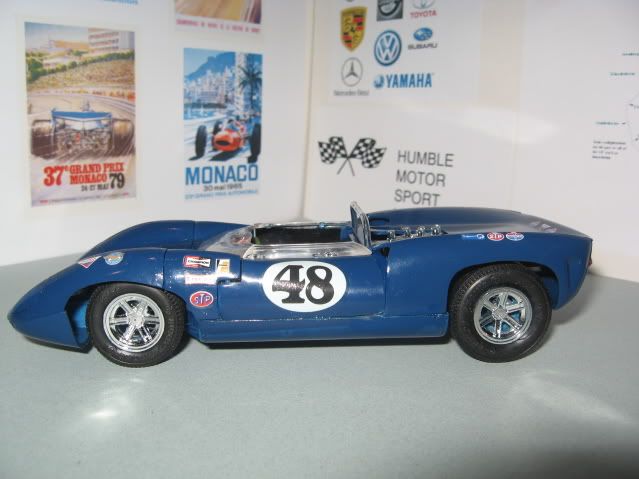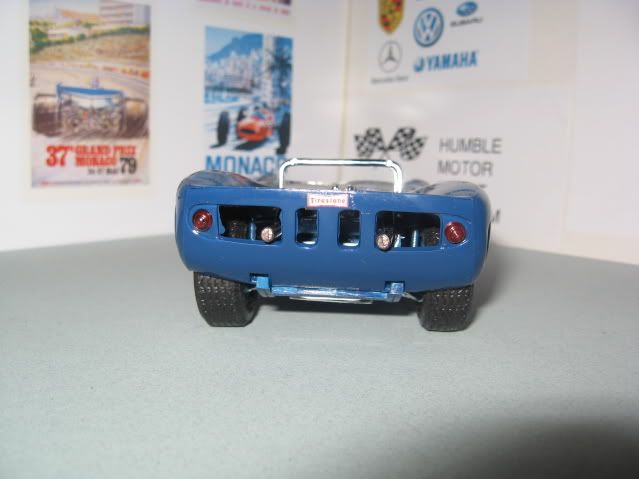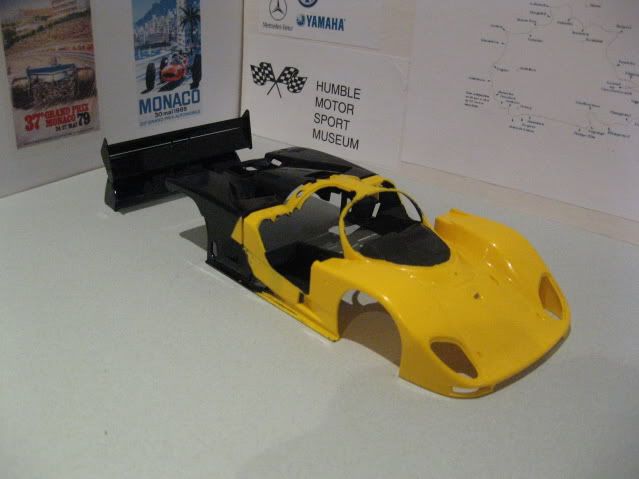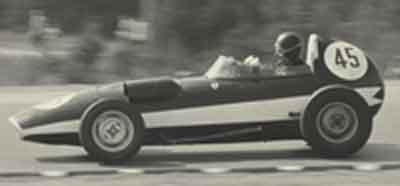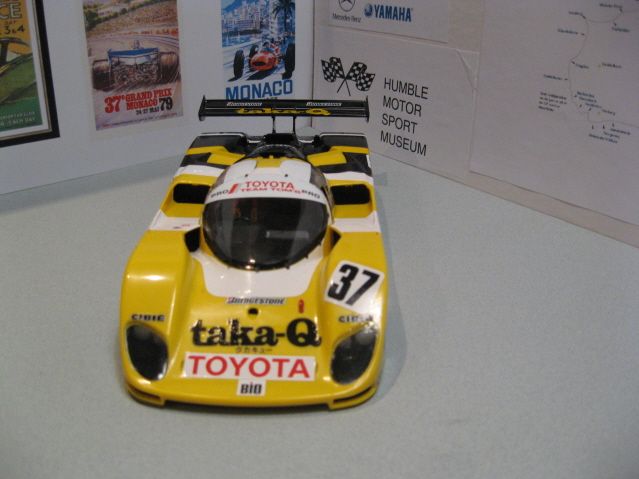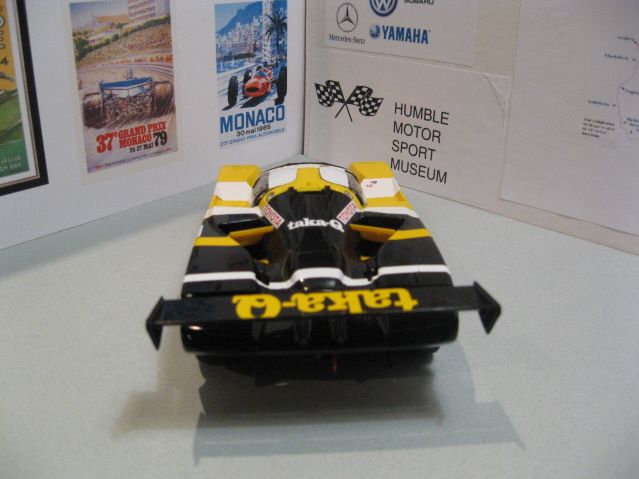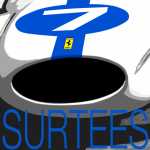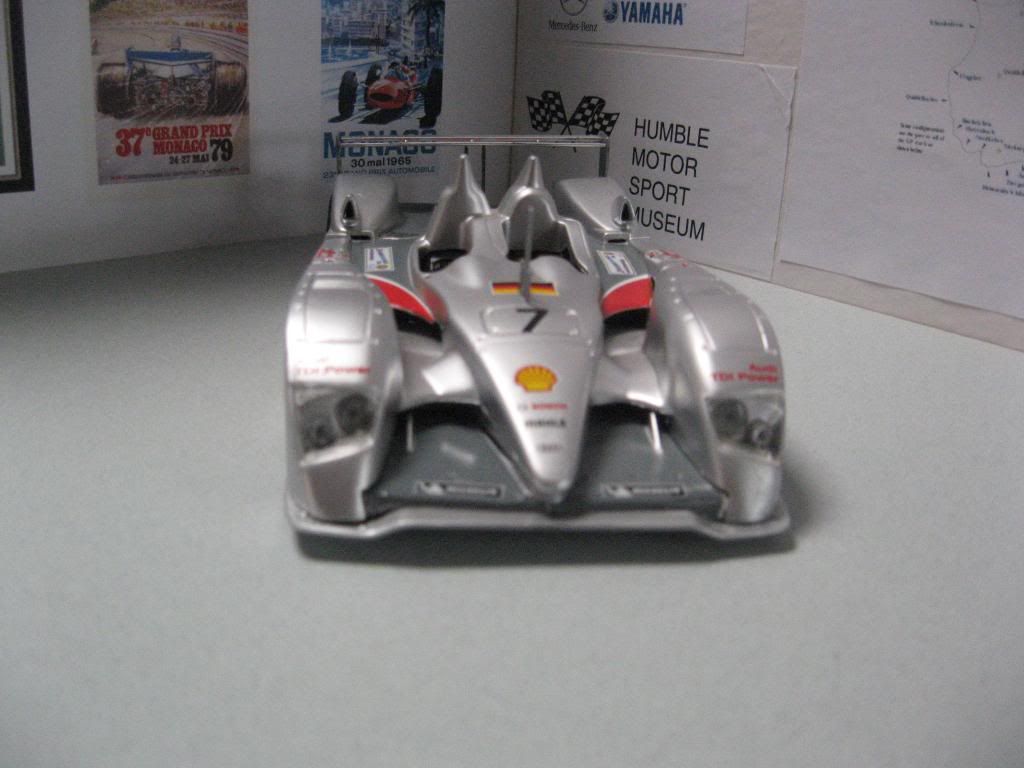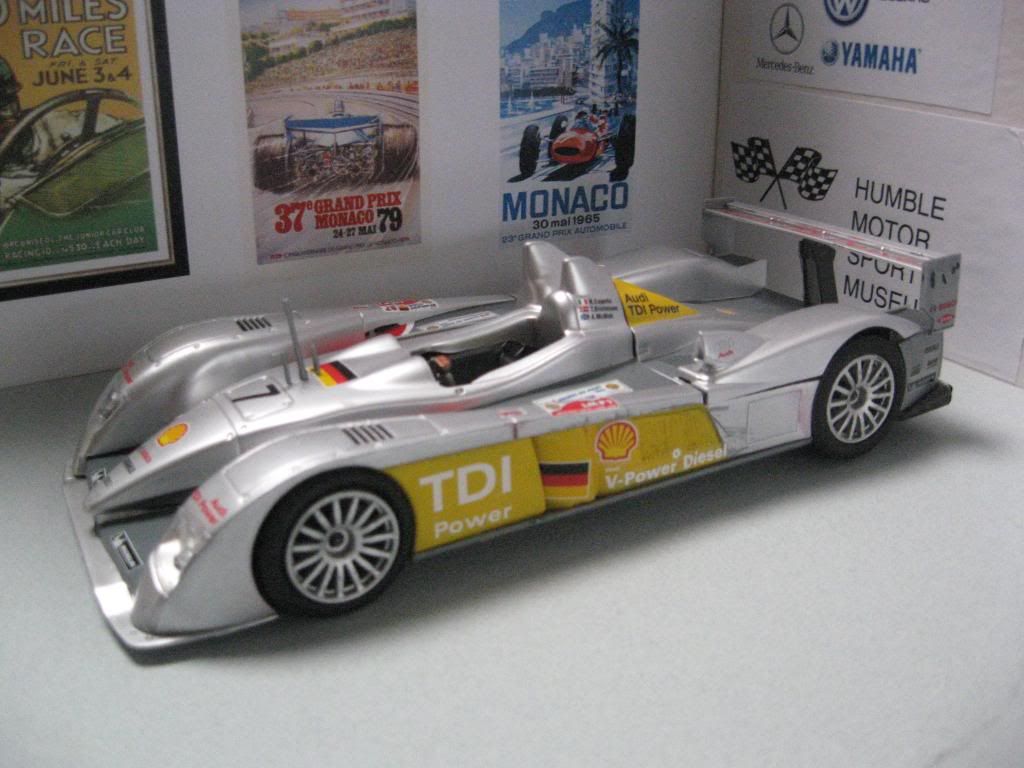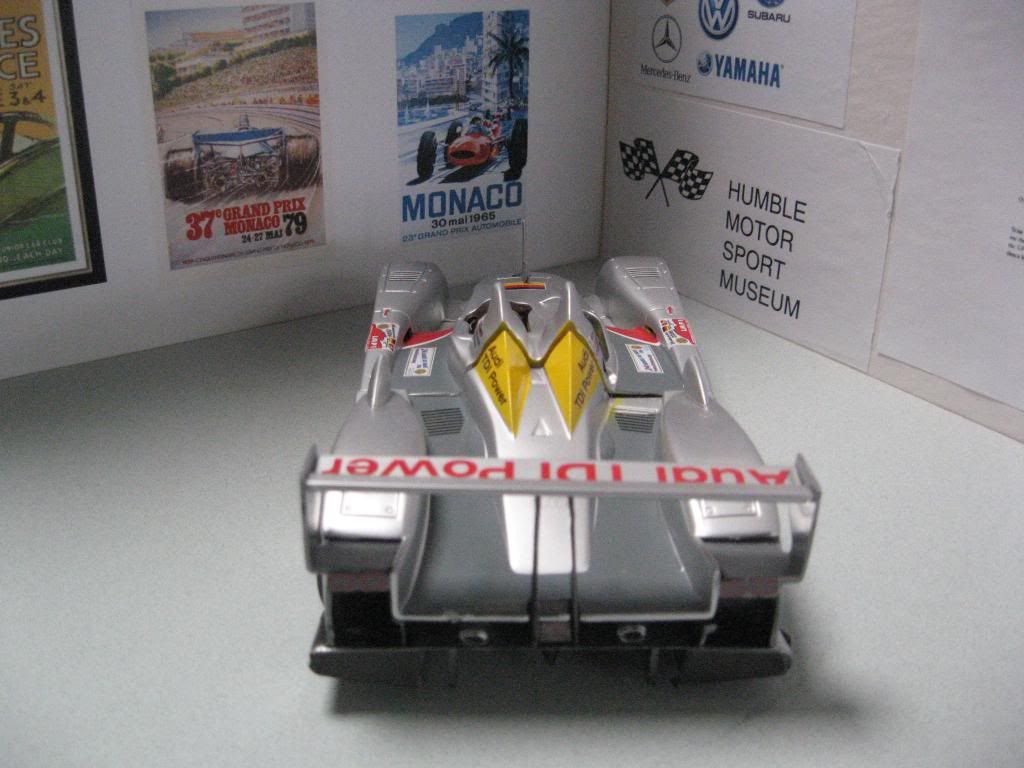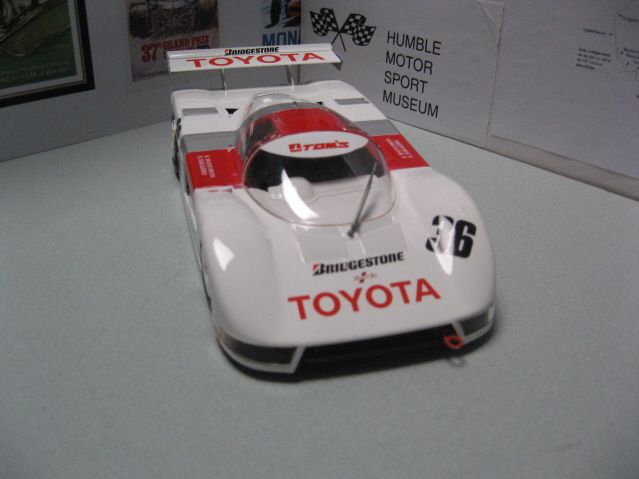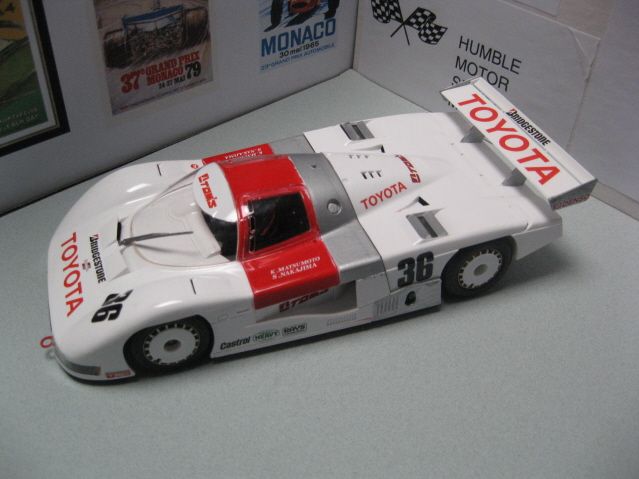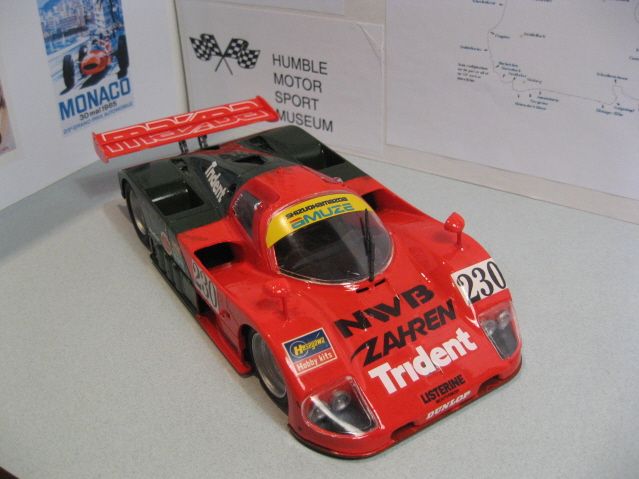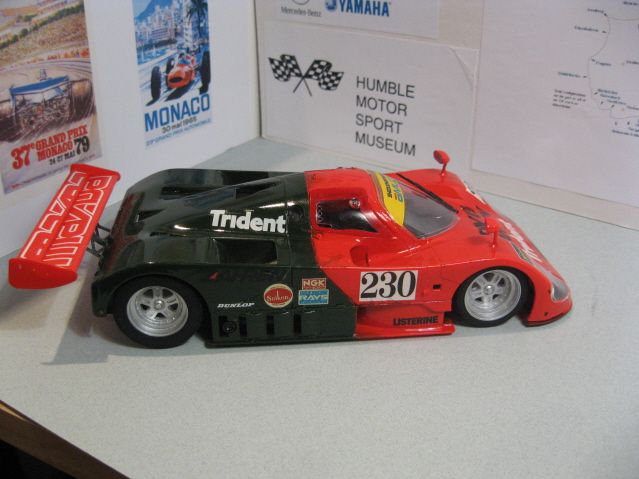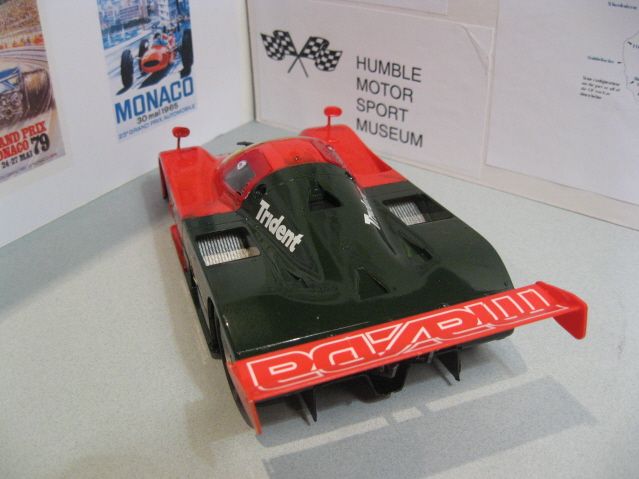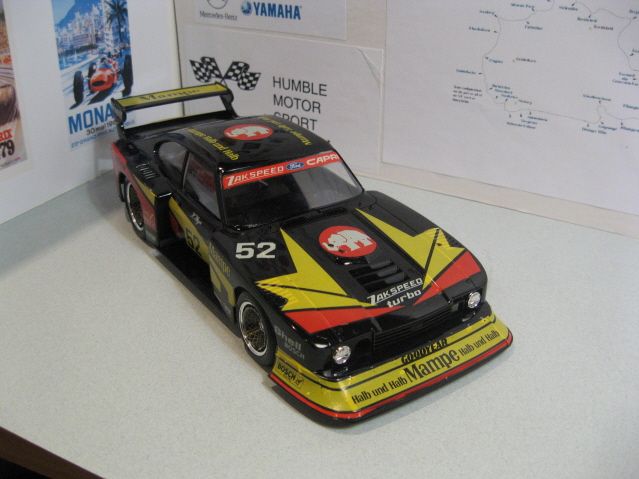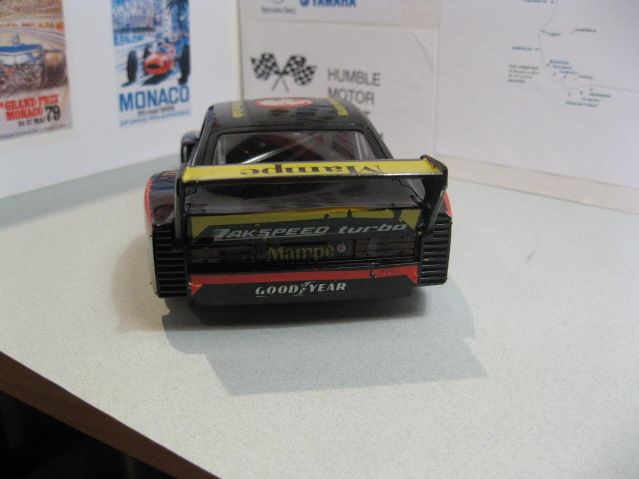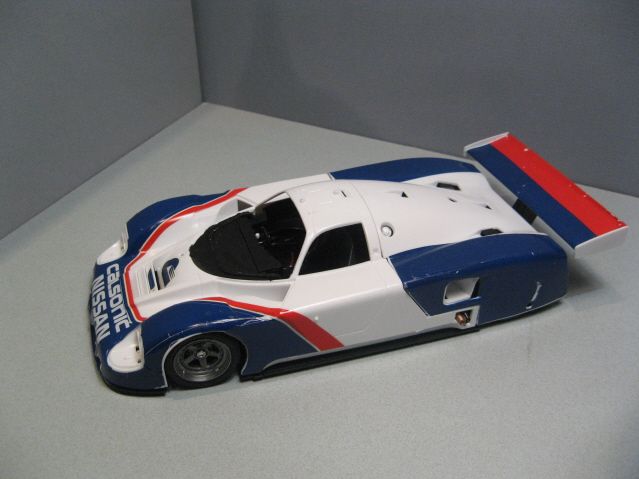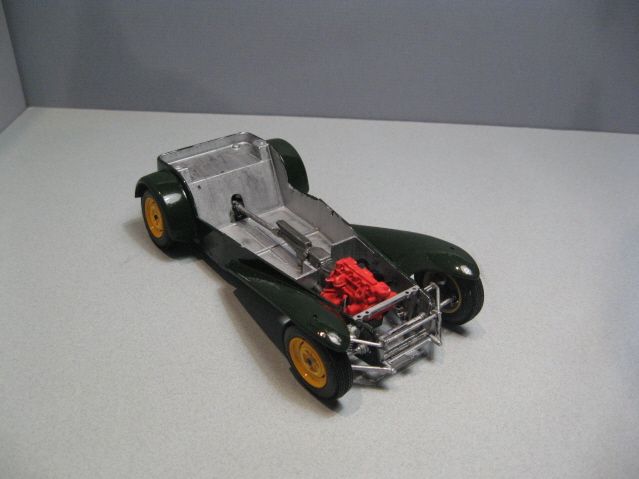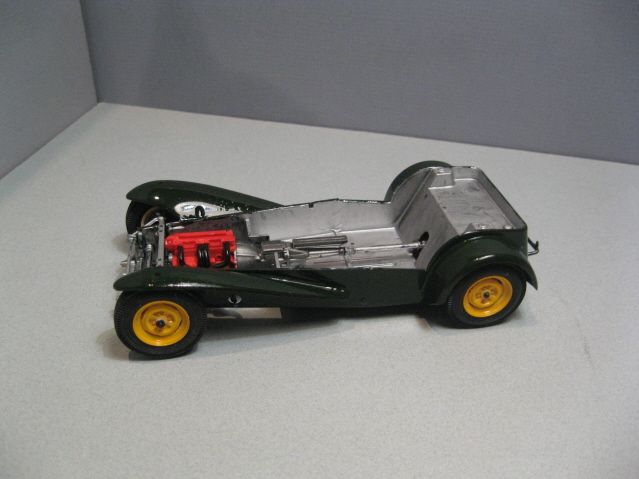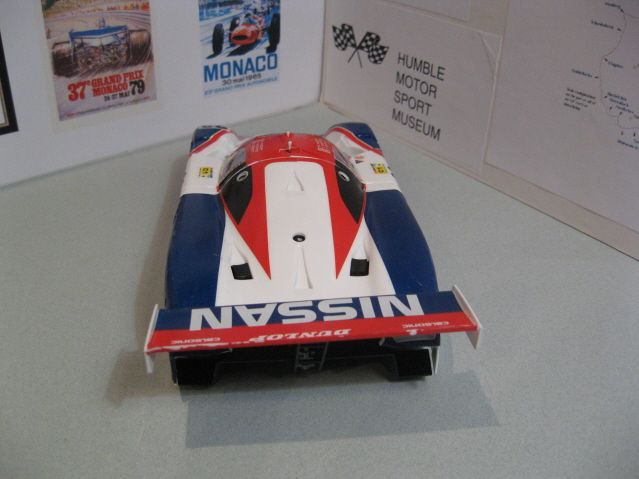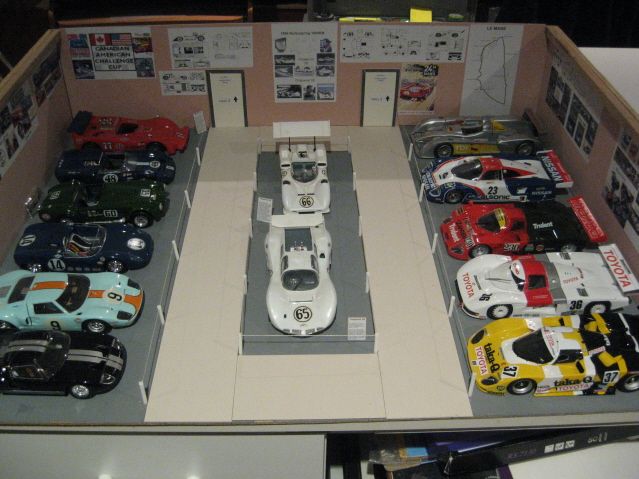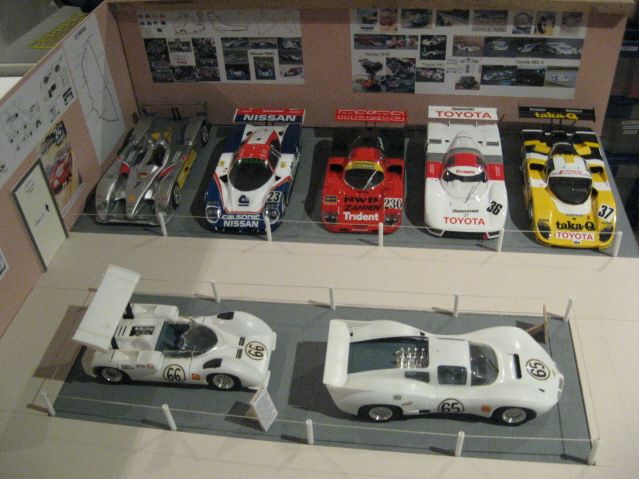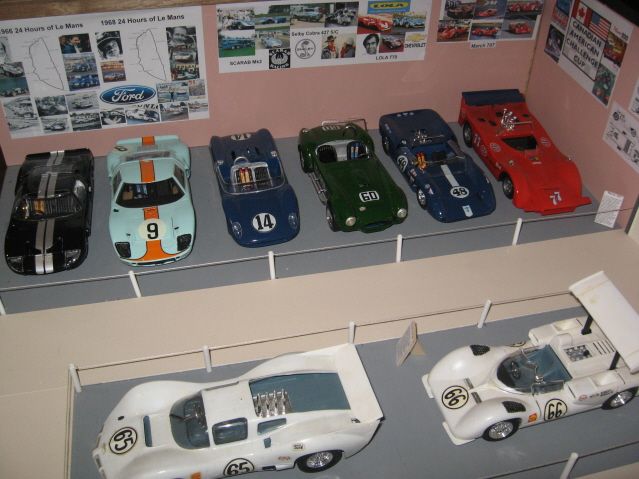Post by Deleted on Dec 8, 2012 18:59:26 GMT -5
Gents:
Humble Gallery 2 - US Endurance racing, CAN-AM, and Japanese built Endurance Racing (also - look out for a "ring-in" a little later in the line-up! )
)
FORD GT40:
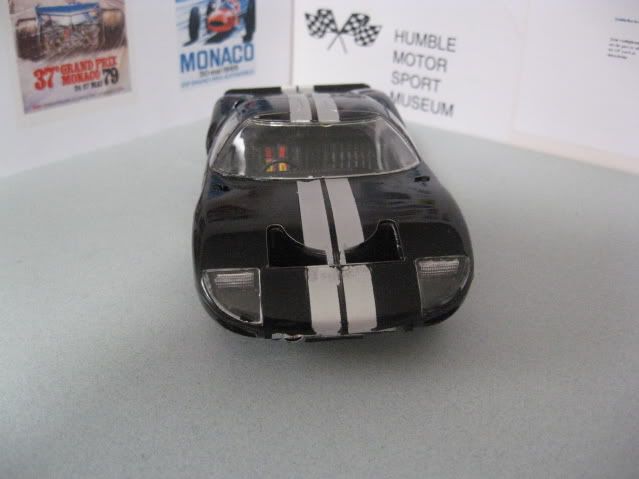

FORD GT 40
The Ford GT40 was a high performance sports car and winner of the 24 hours of Le Mans four times in a row, from 1966 to 1969 (in 1967 with a different body, though). It was built to win long-distance sports car races against Ferrari (who won a Le Mans six times in a row from 1960 to 1965). The 1967 car used the Gurney Weslake engine with the special alloy heads made by Weslake.
The car was named the GT (for Grand Touring) with the 40 representing its overall height of 40 inches (1.02 m, measured at the windshield) as required by the rules. Large displacement Ford V8 engines (4.7 L and 7 L) were used compared with the Ferrari V12 which displaced 3.0 L or 4.0 L. Early cars were simply named "Ford GT". The name "GT40" was the name of Ford's project to prepare the cars for the international endurance racing circuit, and the quest to win the 24 Hours of Le Mans. The first 12 "prototype" vehicles carried serial numbers GT-101 through GT-112. The "production" began and the subsequent cars, the MkI, MkIIs, MkIIIs, and MkIVs, numbered GT40P/1000 through GT40P/1145, were officially "GT40s". The name of Ford's project and the serial numbers dispel the story that "GT40" was "only a nickname."
Two cars are on display here. The first is the black GT40 Mk II with a 7 litre V8 engine, driven by New Zealanders Bruce McLaren and Chris Amon to victory at the 1966 Le Mans race, bringing Ford their first victory in the classic race. The second car here, chassis number GT40P/1075 fitted with a 4.9 litre V8, is the vehicle driven to victory in the 1968 Le Mans race by Pedro Rodriguez and Lucien Bianchi (as displayed), and again the year after in the hands of Jacki Ickx and Jackie Oliver.
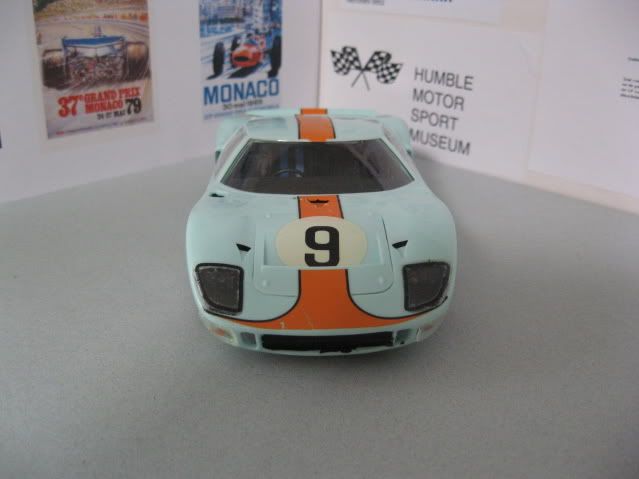
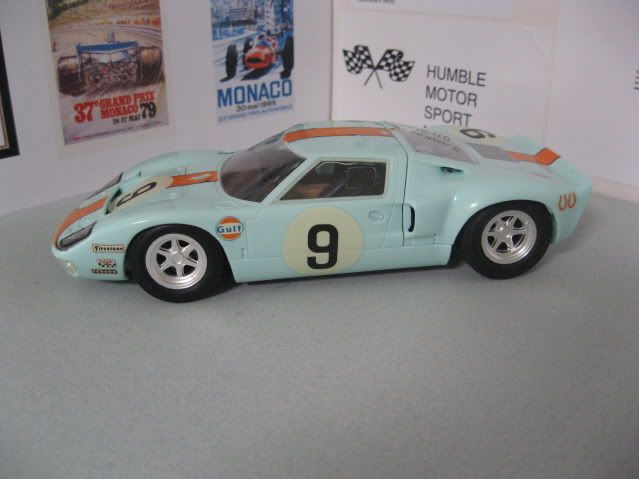
Shelby Cobra:
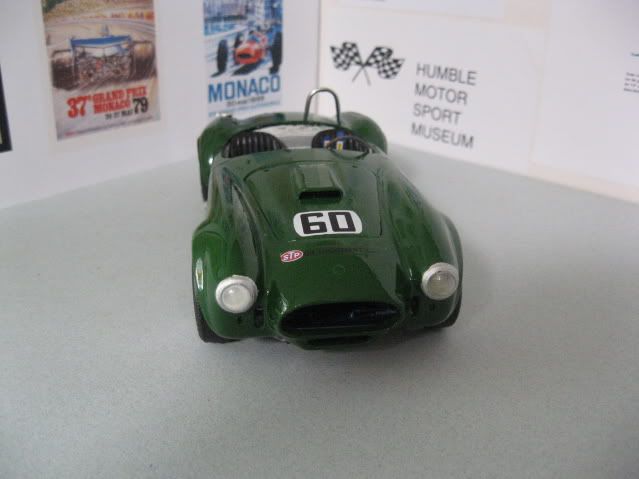
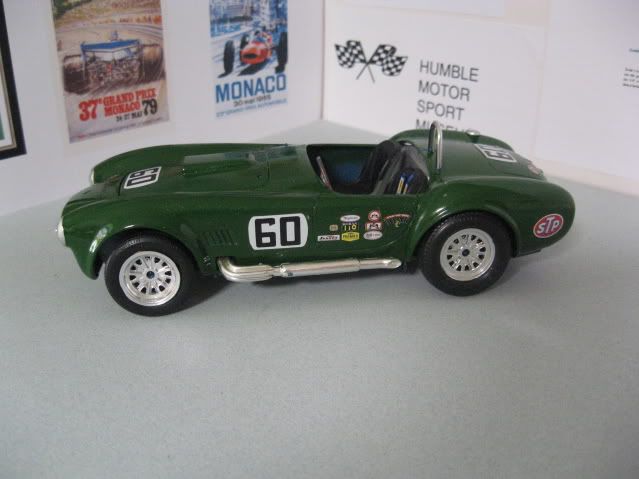
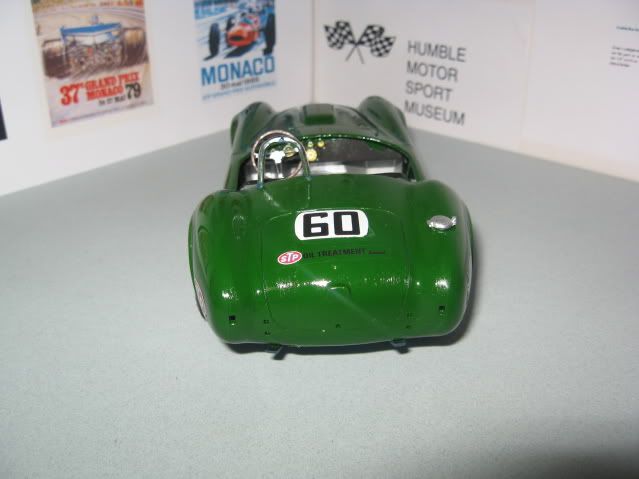
SHELBY COBRA 427S/C
The Cobra began in 1961 as Carroll's cleverly brokered marriage between the aging-but-light British A.C. Ace roadster and Ford's lively new 260-cid V-8. A stronger 289 quickly followed, giving race-tuned Cobras up to 380 horsepower and overall 1963 crowns in SCCA A-production and the U.S. Road Racing Championship.
Shelby built 655 small-block Cobras by 1965, when he introduced an even harrier "sport car" (as he termed the breed). Because A.C.'s old transverse-leaf spring suspension was never up to Cobra power, the steel multi-tube frame was widened and strengthened for a modern all-coil setup (still with double wishbones) and for Ford big-block V-8s: either the high-strung racing 427 or the cheaper but equally torquey 428-cid passenger-car unit. The roadster's aluminium body was suitably altered, gaining macho flared fenders stretched over gumball tyres.
Of all the Cobra variants the 427 Semi/Competition or S/C is the most desirable series. Built from Shelby's competition production line, these were purposeful race cars that were prepared at the last minute for the road.
The story of the Cobra begins as early as 1959 when Carol Shelby raced for Aston Martin, winning the 24 Hours of Le Mans. Along the way he probably took notice of a well performing AC Ace that would become a foundation for his next venture. After quitting racing, he return to America to build his own sports car, turning to Charles Hurlock of AC to supply a chassis and body that was suitable for the new 260 cubic inch Ford V8. After considerable racing success, Ford provided the even larger 427 FE engine. By 1965, chief engineer Ken Miles wanted to fit the engine to win SCCA’s A Production Class and stay ahead of the Corvette Grand Sport.
The Ford 427 was actually a 425 cubic inch V8 developed for the 427 NASCAR regulations. These were strictly race engines with solid lifters and became know for their side oil passage that sent oil to crank first before the valve train. Somewhere around 400 bhp was realised.
With assistance from Ford and AC Cars, the team at Shelby American modified the existing AC chassis design to accommodate the big block engine. The completed design was called the mark III chassis was manufactured with larger and wider spaced chassis rails. Shelby ordered 100 of these from AC Cars. Due to the weight of the engine the brakes and suspension were also upgraded. The body was featured prominent wheel arches to fit wider magnesium wheels and tires. Competition features included an oil cooler, side exhausts, large fuel filler, 42-gallon fuel tank, front jacking points and a roll bar.
Naturally, the 427 Cobra was expected to compete at the top level of motorsport and abroad. Shelby went into immediate production, finishing just over 50 cars when bad news struck. The FIA visited and was unsatisfied with the minimum number of cars required to homologate the 427 in the World Sports Car Championship. Needing 100 cars or more, Shelby's market was immediately slashed, he cancelled his order with AC, but still had 53 big block Cobras nearly completed, one of which is displayed here.
Chaparral 2D:
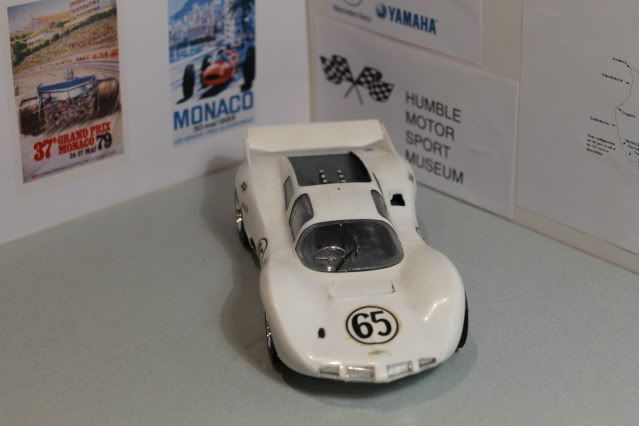
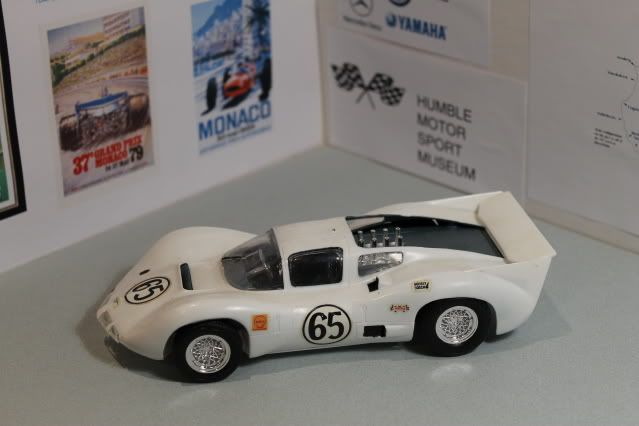
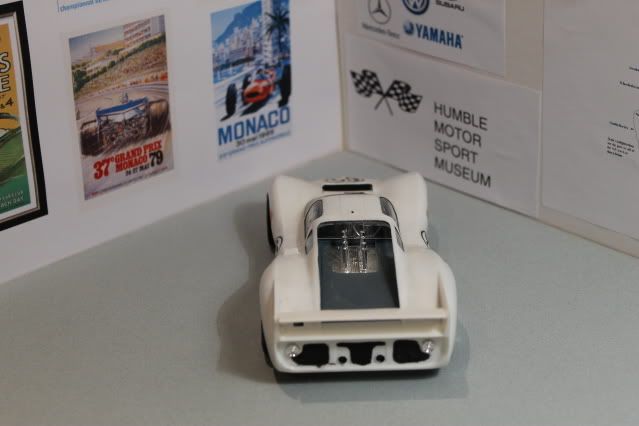
CHAPARRAL 2D
Chaparral Cars was a United States automotive company which built prototype race cars from the 1960s through the early 1980s. Chaparral was founded by Jim Hall, a Texas oil magnate with an impressive combination of skills in engineering and race car driving. Throughout the 1960s and 1970s, Chaparral's distinctive race cars experienced strong success in both American and European racing circuits. Despite winning the Indy 500 in 1980, the Chaparrals left motor racing in 1982. Chaparral cars also featured in the Can Am series and in the European Group 7. It is also said in popular culture that the Chaparral race cars were barred from events because of them being too effective and fast, especially the 2J.
Chaparral was the first to introduce effectively designed air dams and spoilers ranging from the tabs attached to the earliest 2 model to the driver-controlled high wing 'flipper' on the astoundingly different looking 2E, all the way through to Hall's most idealistically inspired creation, the 2J, the car that would forever be known as the 'vacuum cleaner'. The use by Jim Hall of a semi-automatic transmission in the Chaparral created flexibility in the use of adjustable aerodynamic devices.
The 2D (on display here) was a closed cockpit variant of the 2 series designed for endurance racing. It won at the 1000 km of Nürburgring in 1966 with Phil Hill Joakim Bonnier driving.
Chaparral 2E
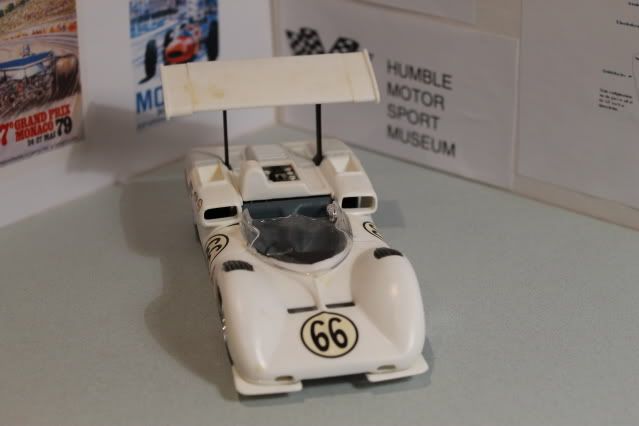
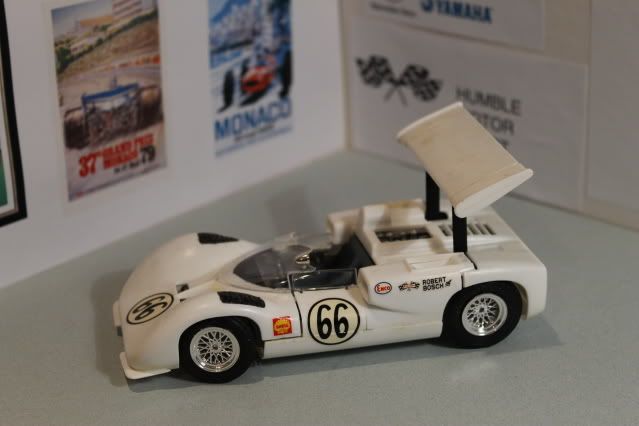
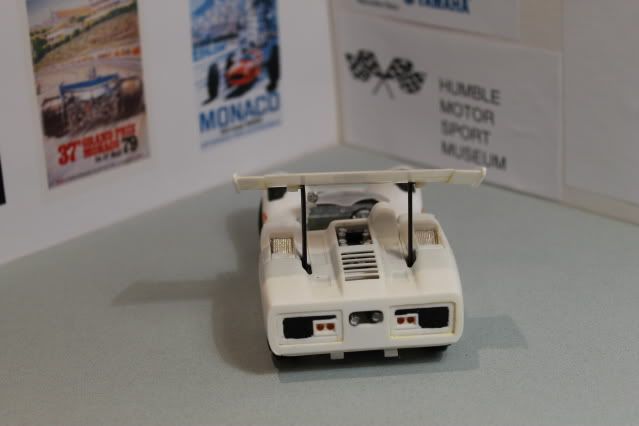
CHAPARRAL 2E
Chaparral was the first to introduce effectively designed air dams and spoilers ranging from the tabs attached to the earliest 2 model to the driver-controlled high wing 'flipper' on the astoundingly different looking 2E, all the way through to Hall's most idealistically inspired creation, the 2J, the car that would forever be known as the 'vacuum cleaner'. The use by Jim Hall of a semi-automatic transmission in the Chaparral created flexibility in the use of adjustable aerodynamic devices.
The 2E was based on the Chevrolet designed aluminium 2C chassis and presented Jim Hall's most advanced aerodynamic theories to the racing world in the 1966 inaugural
Can Am championship. The 2E established the paradigm for virtually all racing cars built since. It was startling in appearance, with its radiators moved from the traditional location in the nose to two ducted pods on either side of the cockpit and a large wing mounted several feet above the rear of the car on struts. The wing was the opposite of an aircraft wing in that it generated down force instead of lift and was attached directly to the rear hubs, loading the tires, for extra adhesion while cornering. A ducted nose channelled air from the front of the car up, creating extra down force as well. By depressing a pedal that was in the position of the clutch pedal on a car with a manual transmission, Hall was able to feather, or flatten out, the angle of the wing when down force was not needed, such as on a straight section of the track, to reduce drag and increase top speed. In addition, an interconnected air dam closed off the nose ducting for streamlining as well. When the pedal was released, the front ducting and wing returned to their full down force position. It was a brilliant design. But the moveable-wing was banned by the FIA so Jim Hall had to make do with a fixed-wing which was not adjustable by the driver during the race. Within two years every sport racing car as well as formula one car had wings on tall struts, although many were not as well designed as Hall's and the resulting accidents from their failures caused the high wings to be outlawed by the sanctioning bodies.
SCARAB Sports Car
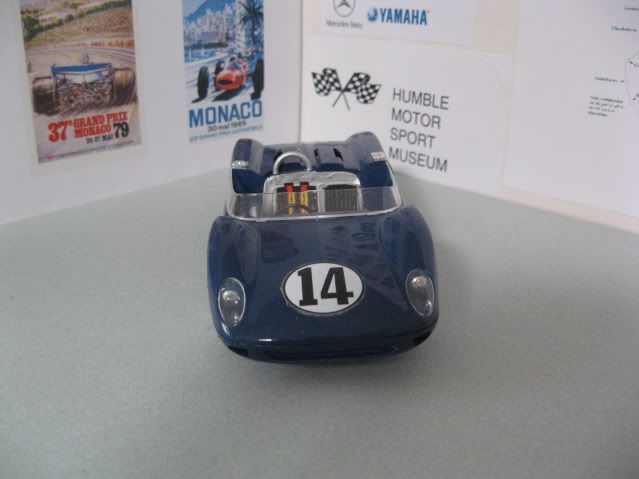
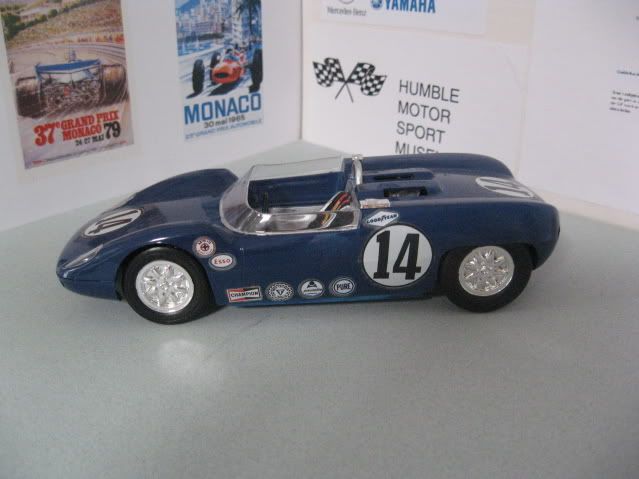
SCARAB SORTS CAR
Scarab was an all-American open-wheel race car and sports car constructor from the USA featuring cars designed and built by Tom Barnes and Dick Troutman for Reventlow Automobiles Inc, owned by Lance Reventlow. The Chevrolet engines were built by Traco Engineering (Jim Travers and Frank Coons, nicknamed "The Whiz Kids").
Troutman and Barnes built sports cars for amateur road racing in the USA in the 1950s. Chuck Daigh drove the Scarab sports car to victory in the 1958 Riverside International Grand Prix, beating a field of international factory teams including famous race car driver Phil Hill and the Ferrari Team. Carroll Shelby drove the Scarab sports car to victory at the Continental Divide raceway in Castle Rock Colorado setting a new course record. A mid-engined two-seat sports car was built. They put the Buick V8 engine in this car and Lance wanted to test it on the streets of Los Angeles. So, he went to the California Department of Motor Vehicles and (after installing a muffler) managed to get license plates for this all-out racing car! He personally raced the car (without muffler) three times and his best finish was second at Santa Barbara. Reventlow was planning on closing down the Scarab operation so he sold this little sports racing car to John Mecom, Jr. of Houston Texas. Mecom installed a Traco-built 327 Chevy engine and put A.J. Foyt in the car. Foyt's best result was winning a pair of races at Nassau, Bahamas during 1963.
MARCH 707

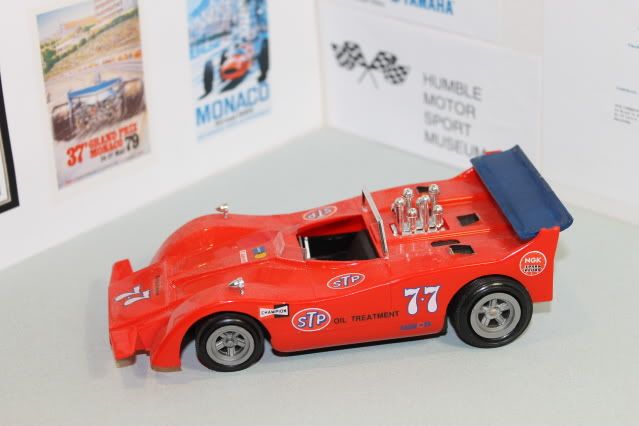

MARCH 707 CHEV
In the second half of the 1960s, the Canadian American Challenge (Can-Am) had become incredibly popular. The cars competing in the Can-Am were based on the virtually unrestricted Group 7 regulations, making them among the fastest machines ever raced.
The cars design followed that of the McLaren M8 with a full width aluminium monocoque. The monocoque ended right after the cockpit with the engine and gearbox mounted in an easily detachable steel sub frame. Suspension was by double wishbones on both ends and vented discs provided the stopping power. Power came from a massive big block Chevrolet V8 engine, producing well over 700 bhp. The most unusual part of the highly conventional package was the body, which featured a full width front wing with moveable canards. The nose design was similar to that of the 1970 March Formula 1 car. Continuing March' simple naming policy, the new racer was dubbed 707; the 1970 Group 7 car.
Painted in a lively red and sponsored by STP, the car displayed here was entered by the Works in the final three rounds of the 1970 Can-Am series for Chris Amon. Herd did not have the illusion that the 707 could immediately challenge the dominant McLarens and wanted to use the three races to iron out the bugs. Amon impressed with a third on the grid at the car's debut. He eventually finished the race in fifth and then scored two fourth place finishes. It is safe to say that the new March performed surprisingly well, despite being slightly overweight.
(Next car coming is a Lola T70 Mk2 Can-Am car. This will be followed by the Japanese built vehicles - Toyota's, Nissan, Mazda)
Humble Gallery 2 - US Endurance racing, CAN-AM, and Japanese built Endurance Racing (also - look out for a "ring-in" a little later in the line-up!
 )
)FORD GT40:


FORD GT 40
The Ford GT40 was a high performance sports car and winner of the 24 hours of Le Mans four times in a row, from 1966 to 1969 (in 1967 with a different body, though). It was built to win long-distance sports car races against Ferrari (who won a Le Mans six times in a row from 1960 to 1965). The 1967 car used the Gurney Weslake engine with the special alloy heads made by Weslake.
The car was named the GT (for Grand Touring) with the 40 representing its overall height of 40 inches (1.02 m, measured at the windshield) as required by the rules. Large displacement Ford V8 engines (4.7 L and 7 L) were used compared with the Ferrari V12 which displaced 3.0 L or 4.0 L. Early cars were simply named "Ford GT". The name "GT40" was the name of Ford's project to prepare the cars for the international endurance racing circuit, and the quest to win the 24 Hours of Le Mans. The first 12 "prototype" vehicles carried serial numbers GT-101 through GT-112. The "production" began and the subsequent cars, the MkI, MkIIs, MkIIIs, and MkIVs, numbered GT40P/1000 through GT40P/1145, were officially "GT40s". The name of Ford's project and the serial numbers dispel the story that "GT40" was "only a nickname."
Two cars are on display here. The first is the black GT40 Mk II with a 7 litre V8 engine, driven by New Zealanders Bruce McLaren and Chris Amon to victory at the 1966 Le Mans race, bringing Ford their first victory in the classic race. The second car here, chassis number GT40P/1075 fitted with a 4.9 litre V8, is the vehicle driven to victory in the 1968 Le Mans race by Pedro Rodriguez and Lucien Bianchi (as displayed), and again the year after in the hands of Jacki Ickx and Jackie Oliver.


Shelby Cobra:



SHELBY COBRA 427S/C
The Cobra began in 1961 as Carroll's cleverly brokered marriage between the aging-but-light British A.C. Ace roadster and Ford's lively new 260-cid V-8. A stronger 289 quickly followed, giving race-tuned Cobras up to 380 horsepower and overall 1963 crowns in SCCA A-production and the U.S. Road Racing Championship.
Shelby built 655 small-block Cobras by 1965, when he introduced an even harrier "sport car" (as he termed the breed). Because A.C.'s old transverse-leaf spring suspension was never up to Cobra power, the steel multi-tube frame was widened and strengthened for a modern all-coil setup (still with double wishbones) and for Ford big-block V-8s: either the high-strung racing 427 or the cheaper but equally torquey 428-cid passenger-car unit. The roadster's aluminium body was suitably altered, gaining macho flared fenders stretched over gumball tyres.
Of all the Cobra variants the 427 Semi/Competition or S/C is the most desirable series. Built from Shelby's competition production line, these were purposeful race cars that were prepared at the last minute for the road.
The story of the Cobra begins as early as 1959 when Carol Shelby raced for Aston Martin, winning the 24 Hours of Le Mans. Along the way he probably took notice of a well performing AC Ace that would become a foundation for his next venture. After quitting racing, he return to America to build his own sports car, turning to Charles Hurlock of AC to supply a chassis and body that was suitable for the new 260 cubic inch Ford V8. After considerable racing success, Ford provided the even larger 427 FE engine. By 1965, chief engineer Ken Miles wanted to fit the engine to win SCCA’s A Production Class and stay ahead of the Corvette Grand Sport.
The Ford 427 was actually a 425 cubic inch V8 developed for the 427 NASCAR regulations. These were strictly race engines with solid lifters and became know for their side oil passage that sent oil to crank first before the valve train. Somewhere around 400 bhp was realised.
With assistance from Ford and AC Cars, the team at Shelby American modified the existing AC chassis design to accommodate the big block engine. The completed design was called the mark III chassis was manufactured with larger and wider spaced chassis rails. Shelby ordered 100 of these from AC Cars. Due to the weight of the engine the brakes and suspension were also upgraded. The body was featured prominent wheel arches to fit wider magnesium wheels and tires. Competition features included an oil cooler, side exhausts, large fuel filler, 42-gallon fuel tank, front jacking points and a roll bar.
Naturally, the 427 Cobra was expected to compete at the top level of motorsport and abroad. Shelby went into immediate production, finishing just over 50 cars when bad news struck. The FIA visited and was unsatisfied with the minimum number of cars required to homologate the 427 in the World Sports Car Championship. Needing 100 cars or more, Shelby's market was immediately slashed, he cancelled his order with AC, but still had 53 big block Cobras nearly completed, one of which is displayed here.
Chaparral 2D:



CHAPARRAL 2D
Chaparral Cars was a United States automotive company which built prototype race cars from the 1960s through the early 1980s. Chaparral was founded by Jim Hall, a Texas oil magnate with an impressive combination of skills in engineering and race car driving. Throughout the 1960s and 1970s, Chaparral's distinctive race cars experienced strong success in both American and European racing circuits. Despite winning the Indy 500 in 1980, the Chaparrals left motor racing in 1982. Chaparral cars also featured in the Can Am series and in the European Group 7. It is also said in popular culture that the Chaparral race cars were barred from events because of them being too effective and fast, especially the 2J.
Chaparral was the first to introduce effectively designed air dams and spoilers ranging from the tabs attached to the earliest 2 model to the driver-controlled high wing 'flipper' on the astoundingly different looking 2E, all the way through to Hall's most idealistically inspired creation, the 2J, the car that would forever be known as the 'vacuum cleaner'. The use by Jim Hall of a semi-automatic transmission in the Chaparral created flexibility in the use of adjustable aerodynamic devices.
The 2D (on display here) was a closed cockpit variant of the 2 series designed for endurance racing. It won at the 1000 km of Nürburgring in 1966 with Phil Hill Joakim Bonnier driving.
Chaparral 2E



CHAPARRAL 2E
Chaparral was the first to introduce effectively designed air dams and spoilers ranging from the tabs attached to the earliest 2 model to the driver-controlled high wing 'flipper' on the astoundingly different looking 2E, all the way through to Hall's most idealistically inspired creation, the 2J, the car that would forever be known as the 'vacuum cleaner'. The use by Jim Hall of a semi-automatic transmission in the Chaparral created flexibility in the use of adjustable aerodynamic devices.
The 2E was based on the Chevrolet designed aluminium 2C chassis and presented Jim Hall's most advanced aerodynamic theories to the racing world in the 1966 inaugural
Can Am championship. The 2E established the paradigm for virtually all racing cars built since. It was startling in appearance, with its radiators moved from the traditional location in the nose to two ducted pods on either side of the cockpit and a large wing mounted several feet above the rear of the car on struts. The wing was the opposite of an aircraft wing in that it generated down force instead of lift and was attached directly to the rear hubs, loading the tires, for extra adhesion while cornering. A ducted nose channelled air from the front of the car up, creating extra down force as well. By depressing a pedal that was in the position of the clutch pedal on a car with a manual transmission, Hall was able to feather, or flatten out, the angle of the wing when down force was not needed, such as on a straight section of the track, to reduce drag and increase top speed. In addition, an interconnected air dam closed off the nose ducting for streamlining as well. When the pedal was released, the front ducting and wing returned to their full down force position. It was a brilliant design. But the moveable-wing was banned by the FIA so Jim Hall had to make do with a fixed-wing which was not adjustable by the driver during the race. Within two years every sport racing car as well as formula one car had wings on tall struts, although many were not as well designed as Hall's and the resulting accidents from their failures caused the high wings to be outlawed by the sanctioning bodies.
SCARAB Sports Car


SCARAB SORTS CAR
Scarab was an all-American open-wheel race car and sports car constructor from the USA featuring cars designed and built by Tom Barnes and Dick Troutman for Reventlow Automobiles Inc, owned by Lance Reventlow. The Chevrolet engines were built by Traco Engineering (Jim Travers and Frank Coons, nicknamed "The Whiz Kids").
Troutman and Barnes built sports cars for amateur road racing in the USA in the 1950s. Chuck Daigh drove the Scarab sports car to victory in the 1958 Riverside International Grand Prix, beating a field of international factory teams including famous race car driver Phil Hill and the Ferrari Team. Carroll Shelby drove the Scarab sports car to victory at the Continental Divide raceway in Castle Rock Colorado setting a new course record. A mid-engined two-seat sports car was built. They put the Buick V8 engine in this car and Lance wanted to test it on the streets of Los Angeles. So, he went to the California Department of Motor Vehicles and (after installing a muffler) managed to get license plates for this all-out racing car! He personally raced the car (without muffler) three times and his best finish was second at Santa Barbara. Reventlow was planning on closing down the Scarab operation so he sold this little sports racing car to John Mecom, Jr. of Houston Texas. Mecom installed a Traco-built 327 Chevy engine and put A.J. Foyt in the car. Foyt's best result was winning a pair of races at Nassau, Bahamas during 1963.
MARCH 707



MARCH 707 CHEV
In the second half of the 1960s, the Canadian American Challenge (Can-Am) had become incredibly popular. The cars competing in the Can-Am were based on the virtually unrestricted Group 7 regulations, making them among the fastest machines ever raced.
The cars design followed that of the McLaren M8 with a full width aluminium monocoque. The monocoque ended right after the cockpit with the engine and gearbox mounted in an easily detachable steel sub frame. Suspension was by double wishbones on both ends and vented discs provided the stopping power. Power came from a massive big block Chevrolet V8 engine, producing well over 700 bhp. The most unusual part of the highly conventional package was the body, which featured a full width front wing with moveable canards. The nose design was similar to that of the 1970 March Formula 1 car. Continuing March' simple naming policy, the new racer was dubbed 707; the 1970 Group 7 car.
Painted in a lively red and sponsored by STP, the car displayed here was entered by the Works in the final three rounds of the 1970 Can-Am series for Chris Amon. Herd did not have the illusion that the 707 could immediately challenge the dominant McLarens and wanted to use the three races to iron out the bugs. Amon impressed with a third on the grid at the car's debut. He eventually finished the race in fifth and then scored two fourth place finishes. It is safe to say that the new March performed surprisingly well, despite being slightly overweight.
(Next car coming is a Lola T70 Mk2 Can-Am car. This will be followed by the Japanese built vehicles - Toyota's, Nissan, Mazda)

